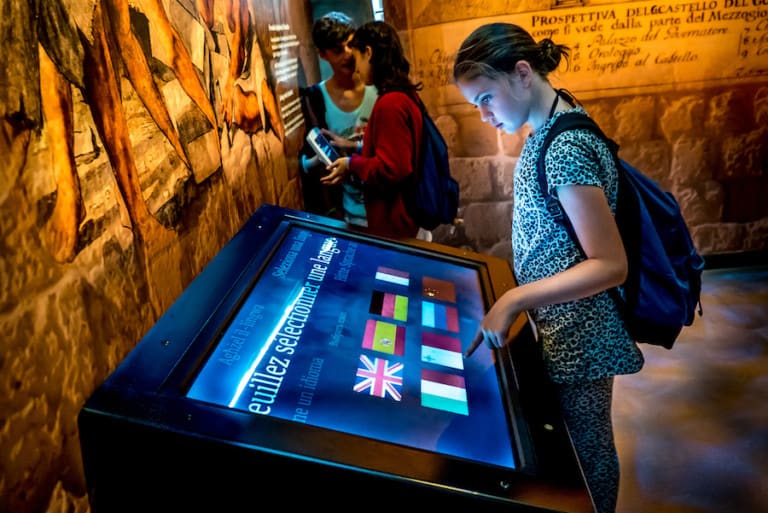By Steven Swaby, Sarner International
We are seeing a long-overdue increase in awareness of inclusivity in museums, theme parks and visitor experiences. But there is still more to do in order to reach a wider audience of visitors who might be feeling excluded.
Immersive storytelling offers more inclusive visitor experiences
Following recent consultations with the Gozo government and the Commission for the Rights of Persons with Disability and the Foundation for Information Technology Accessibility, Sarner International has upgraded its award-winning Cittadella Visitors’ Centre to improve accessibility for guests with hearing and visual impairments. This means that these visitors can now fully immerse themselves in this highly innovative heritage attraction.
Situated at the heart of the beautiful island of Gozo, Malta, the Visitors’ Centre uses the dramatic underground architecture of the Cittadella to interweave a narrative of history, legend and landscape via the latest immersive technologies. It connects past and present, people and place – storytelling that achieves emotional connections and doesn’t just present facts.
Working with audio-visual technology specialists tonwelt, the Sarner team added new custom multimedia guides that do more than just provide tailored accessible tours of the attraction, available in eight languages.
Sophisticated but user-friendly, the guides also extend the immersive experience in several other ways. A noise-reducing audio track automatically subdues the sound of the room, making speech clearer for people with hearing aids or impaired hearing. Subtitled content on the device screen also makes multimedia content more accessible. In addition, braille keyboards can access audio-descriptive versions of each exhibit for blind or partially sighted visitors.
This creative and cost-effective solution has enabled a wider audience to engage in the region’s remarkable history.
A toolkit for inclusive experiences
And the Cittadella Visitors’ Centre isn’t just an isolated example. The delivery of inclusive and innovative design should be a key objective in each and every project, ensuring that content solutions provide an equally rewarding experience for all visitors.
Sarner is continually exploring ways in which wider, better accessibility can be achieved. Over its 50 years of experience in the industry, it has developed a toolkit that allows it to help its clients welcome and engage with visitors of all backgrounds.
Designing smart
Sarner always aims to make its design fully accessible, looking at how to address the needs of the widest possible range of physical and mental conditions. It’s not always just about mobility and access, and neither is it necessarily a matter of budget, either. Technology and know-how have come a long way in providing cost-effective solutions.
Engaging the senses
By creating multisensory experiences, immersive design has a major advantage over limited, less inclusive traditional approaches. By connecting with touch, hearing, smell and even taste, a wider range of visitors can have a far more rewarding experience.
The Met in New York is an example of this. Their multisensory stations allow visitors to explore exhibits using all of the senses. Multisensory books, sculpture and audio paintings are an integral part of the museum experience.
In London, the V&A Museum has been offering tactile events for visually impaired visitors since the 1980s. And now 3D printing to make touchable replica objects is also being explored by many museums around the world.
Controlling the experience
Providing calm areas that allow for downtime, regrouping and contemplation are important for a wide range of visitors. But having greater control of show modes is also key for providing a better experience for visitors with special needs.
Tailored show control allows for session-by-session adjustment of sound volumes, image intensity and overall lighting levels, in the same way that some cinemas offer “autism-friendly screenings”. Having that sort of control at your fingertips allows attractions to deliver a far more adaptable and welcoming visitor experience for all.
Be seen, be heard
Better sightlines and larger text for visitors with limited vision and subtitles for the hearing impaired are simple considerations. But they go a long way in making more inclusive experiences.
Legibility at all stages of text design is standard good practice. It’s also worth remembering that contrast is more important than the size of the text. So, it isn’t just a case of making things bigger!
For hearing-impaired visitors, signed content delivered directly to a user’s device is also proving a popular and effective mode. For instance, The Roald Dahl Museum and Story Centre has developed a Jodi Award-winning app. Here, exhibit signposts trigger signed video content.
Thinking holistically
Diversity, equality and inclusion can be promoted seamlessly as part of the exhibition content and associated public programming.
Pre- and post-visit audience engagement can go a long way in achieving a better understanding of needs, expectations, what works and what could be improved. It can also build a closer relationship between audience and host. People tend to appreciate it if they feel they are being listened to. And who better to advise on enabling effective participation than the end-users!
Know your kit
Finally, staff training is essential for creating and maintaining smooth, welcoming and inclusive experiences. Operational staff should be familiar with the ins and outs of hand-held devices and show controls as well as other visitor experience tech. Awareness of special needs enables a more effective and rewarding experience for both visitors and staff alike. Proper training really does invest in everyone.
In conclusion, it is genuinely encouraging to see social responsibility becoming a guiding principle that is shaping exhibitions and attractions around the globe. The inclusive power of immersive storytelling is a fantastic resource, and it’s there to be tapped into.
